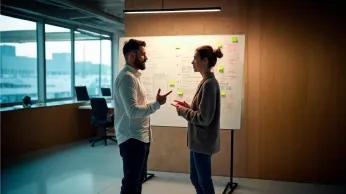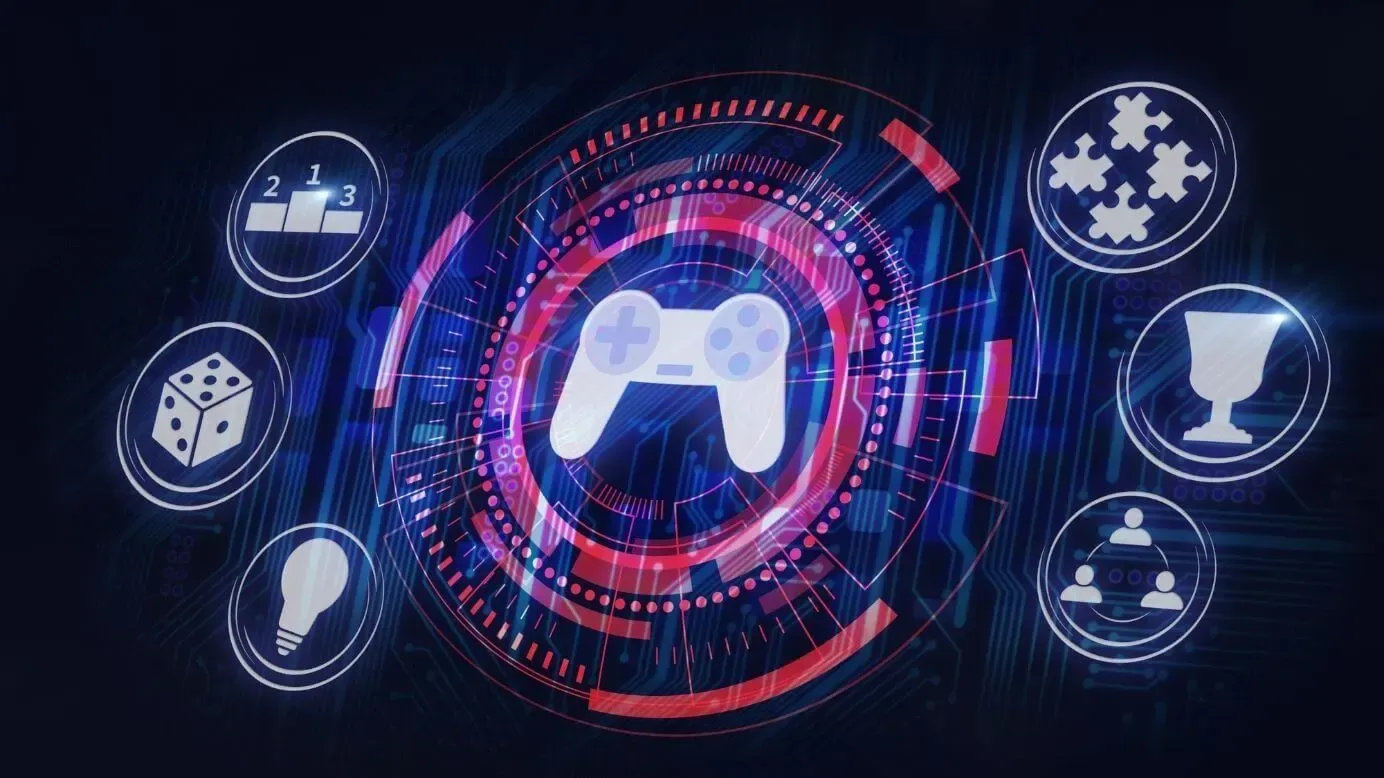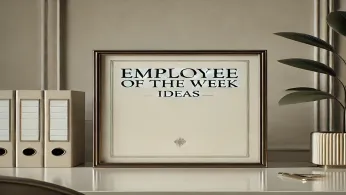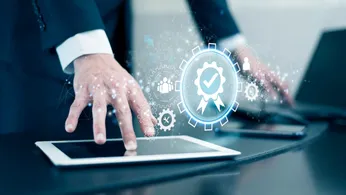How Gamification Boosts Employee Engagement and Performance
Learn how gamification for employee engagement drives motivation, improves performance, and fosters a culture of recognition, collaboration, and goal alignment.
Auf dieser Seite
Did you know that gamified workplace initiatives can increase employee engagement, driving higher productivity and a sense of belongingness? A Forbes article has revealed that 70% of business transformation initiatives fail due to a lack of employee engagement, urging employers to focus on implementing steps for employee engagement.
One of India's largest food ordering and delivery platforms uses gamification to solve the engagement of their colossal workforce of over 2 lakh delivery partners. They gamified their delivery partners' attendance, shift completion, and delivery times using Empuls, an excellent example of how gamification improves employee engagement.
Jedes Mal, wenn die Zustellpartner die Aufgabe erfüllten, einen Tag lang an der Zustellung teilzunehmen, die Zeitvorgaben einzuhalten und ihre Schichtzeiten einzuhalten, erhielten sie automatisch Punkte.
Diese Punkte konnten gesammelt werden, um sich selbst ein Produkt oder eine Dienstleistung ihrer Wahl zu kaufen - was ansonsten mit ihrem Gehaltsscheck nur schwer möglich gewesen wäre. Im sechsten Monat der Umsetzung hatte die Organisation 86 % ihrer Partner eingebunden und die Ziele erreicht.
Considering their operational complexity of being spread across 280+ cities, over 270 of these being tier 2 and tier 3 cities, this achievement is laudable. This reach would have been impossible if not for gamification using scalable technology. The above case is just one of the numerous applications of gamification.
Such an implementation is corroborated by research from Harvard Business School that claims that framing competition as a gain can positively impact an employee’s feeling and their willingness to find creative ways to meet their goals.
Diese Technik wird häufig in den Bereichen Marketing, Innovation, Gesundheit, Crowdsourcing, Lernen, Gemeinschaftsbildung, soziale Anliegen und Engagement am Arbeitsplatz eingesetzt. In diesem Artikel geht es darum, wie Gamification das Engagement am Arbeitsplatz verändern kann.
Was ist Gamification?
Gamification involves integrating game-design elements such as points, badges, and leaderboards into non-gaming contexts to motivate and increase user engagement. In the workplace, this translates to applying these elements to tasks and processes to make them more engaging and rewarding.
1. Yu-kai Chou
Yu-kai Chou, a gamification author, and international keynote speaker tells us that gamification needs to be designed around the 'core drives' of human beings. He classifies these core drives into eight categories: a higher purpose, achievement, empowerment, ownership, social influences, scarcity, unpredictability, and avoidance.
He believes that the most enchanting of gamification designs necessarily address at least one or many of the above 'core drives'.
2. Gabe Zichermann
Gabe Zicchermann, a gamification expert and public speaker, presents an interesting narrative on the biochemistry of gamification. "Any time you challenge yourselves to do a task, it doesn't matter how big or small - and you succeed - your brain secretes a magical little bit of dopamine - which makes you feel really good.
The more you do this 'challenge - achievement - pleasure' loop, the more dopamine is secreted in your brain making you want to do it more. Thus the more you succeed, the more you want to succeed."
Which elements are essential in gamification for employee engagement?
Rajat Paharia, in his book Loyalty 3.0, describes that gamification has a few or many of the following ten elements (also known as game mechanics) to it:
- Immediate feedback: The user knows whether he is winning or losing almost immediately after his actions.
- Leaderboards: The user gets to know where he is positioned from amongst the rest of the users.
- Goals: The user gets to know where they are headed and what they need to achieve.
- Badges: The user receives badges that are shorthand for past achievements.
- Leveling up: The user is taken through ascending levels of difficulty.
- Onboarding: The user is trained well - all during the course of the gameplay itself.
- Competition: The user is competing with other players or groups.
- Collaboration: The user gets to help and take help from other users.
- Community: The user gets to belong to a community of others who have similar gaming interests.
- Points: The user accumulates points throughout the gameplay.
That said, ticking off the elements of gamification does not ensure a valid gamified solution. The author of 'Gamify,' Brian Burke warns us of how a few companies have a misconception that gamification is a magic elixir that can be used to indoctrinate masses to perform the company's bidding. Users can quickly sense poorly designed solutions and start actively avoiding them, leading them to collapse.
When should organizations implement gamification?
Organizations should consider implementing gamification when they observe low employee engagement, high turnover rates, or a lack of motivation. It's particularly effective during onboarding, training, and performance management phases.
Gamified onboarding can enhance the new employee experience by making the process more interactive and informative. Similarly, incorporating gamification into training programs can improve knowledge retention and skill development.
Gestaltung von Gamification zur Mitarbeiterbindung
Brian Burke in his books and Yu-kai Chou continually emphasizes how a gamification design needs to incorporate 'core drives' or intrinsic motivations of the user. This means the game architect needs to go beyond game mechanics and study the true motivations of the target users. Along with the business scope, the user's scope in the solution needs to be constantly evaluated.
Brian Burkes leitet die folgenden sieben Schritte ab, die als Rahmen für das Gamification-Design dienen sollten - sowohl für Architekten als auch für Unternehmensleiter:
1. Definition des Geschäftsergebnisses und der Erfolgskennzahlen
Alle Anstrengungen, die in die Gamifizierung einer Lösung gesteckt werden, müssen zwangsläufig mit einem Geschäftsziel verbunden sein. Daher besteht der erste Schritt bei der Entscheidung für eine gamifizierte Unternehmenslösung darin, das Geschäftsziel zu bestimmen, das sie zu lösen versucht.
'20% faster customer first response time' could be an ideal business outcome definition that includes a success metric of '20% improvement' for a typical customer service team.
2. Definition des Zielpublikums
Wer wären die Nutzer der gamifizierten Lösung? Was wird ihr ideales Profil sein? Was treibt sie an? Dies sind wichtige Fragen, um die Zielgruppe in der Tiefe zu verstehen. Je besser dieses Verständnis ist, desto mehr wird die Gamification ihre Hauptantriebe ansprechen.
Referring back to the customer service team, the target audience for gamification will typically be customer service executives. Their job designs are fairly standardized, iterative, and homogeneous. Core drives like 'higher purpose' and 'achievement,' can break this monotony and introduce higher efficiencies if captured in gamification.
3. Festlegung von Spielerzielen
Das Ziel des Spielers muss eine Teilmenge des Geschäftsziels sein und sollte idealerweise mit mindestens einem der Hauptantriebe des typischen Nutzers übereinstimmen.
Burke talks of an example of how a children's cancer treatment center gamified pain reporting by their patients. The kids are made a part of a "Pain Squad" where they pretend to be a police officer. They are then promoted from rookie to sergeant to chief as they regularly report their pain levels.
Drawing a quick inspiration, the customer service executives in our above example could be given a similar goal - to 'put out' or 'solve' a query as quickly as possible.
4. Festlegung des Modells für das Engagement der Spieler
Wie werden sich die Nutzer mit der gamifizierten Lösung beschäftigen? Ist es sinnvoller, es zu einem kollaborativen oder wettbewerbsorientierten Spiel zu machen? Wie lange wird es dauern? Welche Form von Belohnungen wird es geben? Dies sind wichtige Fragen, die vor der Entwurfsphase geklärt werden müssen.
In our example, a 'competitive' engagement model makes direct sense because the executives address customer queries individually. There are ways companies have effectively made customer service gamification collaborative under the assumption of it being impossible for a customer service executive to know ALL the answers to all possible client questions. They create teams of customer executives with mixed specializations and allow them to tackle queries together.
5. Festlegung des Spielraums und Planung des Weges
The environment the gamification is as important as the solution itself. In the context of employee solutions, it is ideal if the 'play space' is close to their CRMs and ERPs. The entire journey of the user's needs to be mapped, level by level, and challenge by challenge.
Customer Service brigadiers could be given faster-level achievements while they solve customer queries faster. There could be leaderboards showing the position of each of the brigadier's achievements and profile badges representing their positions. It is ideal if leaderboards could be reset after a final win - to democratize the opportunity to win and retry. The history of achievements should be recorded both on the profile of the user as well as a 'hall of fame'.
6. Definition der Spielwirtschaft
Was erhält der Nutzer als Gegenleistung für seine Leistungen? Wie können diese weiter abgewickelt werden? Wie werden die Aufzeichnungen über diese Transaktionen archiviert? Die Spielwirtschaft ist der Motor für das Funktionieren all dieser Konzepte, und die Beantwortung der oben genannten kritischen Fragen trägt zur Definition des Spielkonzepts bei.
Since customer service is almost always a direct component of a customer service executive's KRA, better efficiencies could be incentivized using their standard performance rewarding guidelines. Points could be used to track the progress and major milestone wins can be awarded using incentive disbursals.
7. Spielen, testen und iterieren
Wie bei jedem Systemdesign muss auch bei der Gamifizierung die Feedback-Schleife geöffnet und verstanden werden, was geändert werden muss, um die Nutzererfahrung nahtlos zu gestalten. Verbessern Sie kontinuierlich das Design und testen Sie neue Spielmechanismen, die zu einer besseren Akzeptanz der Lösung beitragen könnten.
Talk to the customer service executives one-on-one and understand the challenges they face in the gameplay. Get their feedback on each of the game design aspects. Reinvent parts of it if necessary- say, make it a collaborative gameplay from a competitive one?
Auswirkungen der Gamification auf das Engagement der Mitarbeiter
Bei der Anwendung von Gamification ist es wichtig zu verstehen, wie sie sich auf jeden der unten aufgeführten Hauptfaktoren des Mitarbeiterengagements auswirken kann - da das Mitarbeiterengagement an sich eine komplexe Mischung aus beruflichen Phänomenen ist.
Die individuellen Merkmale der Mitarbeiter gelten als der stärkste Prädiktor für das Engagement der Mitarbeiter, und insbesondere die folgenden Merkmale sind neben anderen wichtig:
1. Selbsteffizienz
This accounts for the individual's perception of how effective his/her skills will be for the organization and the perception of self-efficacy can be nurtured using gamification that incorporates 'pats on the back'. Employee engagement software like Empuls uses 'spot rewards' and 'badges' for this purpose and these have seen enormous results in both reward ROI and engagement.
2. Widerstandsfähigkeit
Dies trägt der Fähigkeit eines Mitarbeiters Rechnung, sich schnell an das geschäftliche und kulturelle Umfeld des Unternehmens anzupassen, und diese Anpassung kann durch eine spielerische Gestaltung der Einführungs- und Schulungsprozesse reibungsloser und schneller erfolgen. Spielmechanismen von "kollaborativen" Ökosystemen können neuen Mitarbeitern helfen, sich schnell einzuarbeiten.
3. Persönliche Kapazitäten
Positive persönliche Eigenschaften wie Hoffnung und Optimismus sind ausschlaggebend dafür, wie sich Mitarbeiter an ein Unternehmen binden. Spielmechanismen wie "Onboarding" können genutzt werden, um OKRs und Jobrollen zu verstärken - um die Erwartungen an die Rolle sehr deutlich zu machen.
4. Arbeitsgestaltungsbezogene Faktoren
Die Gestaltung des Arbeitsplatzes ist das zweitwichtigste Element des Mitarbeiterengagements und umfasst die folgenden Merkmale:
5. Rückmeldung
Giving and receiving feedback is the most significant of all job design features and gamification can very efficiently help nurture a feedback-positive environment. Employee engagement tool and employee gamification software like Empuls use 'immediate feedback' game mechanics like 'high-fives' and '+1s' to get anonymous feedback from the other users.
Gamifizierte Umfragen (für das Ausfüllen einer Umfrage erhält der Nutzer Punkte), Feedback und Umfragen sind bewährte Mittel, um die Beantwortung und Beteiligung zu erhöhen. Sogar die Häufigkeit und Reaktionszeit beim Ausfüllen von Feedback kann verfolgt und gamifiziert werden.
6. Befähigung und Autonomie
Gamification kann effiziente Lösungen zur Förderung von Eigenverantwortung und Autonomie bieten, um Engagement zu schaffen. Gamification von Interaktionen in Arbeitsgruppen und die Vergabe von Punkten für eigenständige Entscheidungen können eine Möglichkeit sein, dies umzusetzen. Punkte für neue Ideen, die Entdeckung von Problemen, Feedback, innovative Vorschläge usw. können zu mehr Arbeitsautonomie führen.
7. Möglichkeiten der Entwicklung
Leveling up", "Badges" und "Leaderboard"-Spielmechanismen sind effiziente Methoden, um eine kontinuierliche Entwicklung der Mitarbeiter zu erreichen. Selbst bei zurückgesetzten Ranglisten zeigen die Stufen und Abzeichen, was der Mitarbeiter in der Vergangenheit erreicht hat. Die Verknüpfung mit Beurteilungsprozessen und Führungsplanung steigert das Potenzial zusätzlich.
8. Wahrgenommene Führung und Management durch den unmittelbaren Vorgesetzten
Auch die Vorgesetzten können die "Zielgruppe" für Gamification sein. Die Entwicklung von Gamification, die die Zeit verfolgt, die ein Vorgesetzter braucht, um Probleme eines Mitarbeiters zu lösen, Aufgaben zu überprüfen, die Häufigkeit von Teaminteraktionen, die Einhaltung der Einführungs- und Wohlfühlrichtlinien des Unternehmens durch den Vorgesetzten usw. Die Spielmechanismen "Wettbewerb" und "Leaderboard" können genutzt werden, um diese unter Managern, die sich in derselben Gruppe befinden, umzusetzen.
9. Wahrnehmung von Organisations- und Teamfaktoren
Das psychosoziale Klima, die Kommunikation, das Vertrauen usw. innerhalb der Organisation sind weitere Faktoren, die das Engagement der Mitarbeiter beeinflussen. Grundwerte bilden die Basis für die Unternehmenskultur und das Klima. Gamification kann diese Werte durch den Einsatz von Spielmechanismen wie "wertbasierte Abzeichen" fördern.
Gamification auf Managerebene kann erstellt werden, um zu verfolgen, wie gut er/sie seinem/ihrem Team die lang- und kurzfristigen Organisationsziele mitteilt und vermittelt.
10. Organisatorische Interventionen oder Aktivitäten
Gamification wird in großem Umfang für Aktivitäten zum Wohlbefinden der Mitarbeiter eingesetzt und hat große Erfolge bei der Verbesserung der Fitness und der Gesamteffizienz der Mitarbeiter gezeigt. Lauf-, Geh- und Trainingskilometer können verfolgt und "Live"-Bestenlisten geführt werden.
People Combine, einer unserer Kunden, hat Trainingsmeilensteine in Spiele umgewandelt und die gesundheitsbedingten Fehlzeiten um 50 % reduziert. Sie nutzten Spielmechanismen wie "Leaderboards", "Leveling Up", "Badges", "Ziele" und "Punkte".
How Empuls, the employee gamification software could help?
Gamify employee rewards & recognition with badges, points, certificates, and leaderboards. Motivate employees and improve performance with a healthy competitive spirit using game mechanics.
Empuls empowers organizations to build a culture of appreciation and high performance by integrating gamification into everyday work experiences. Here's how it supports engagement:
1. Motivates with meaningful recognition
Empuls allows peers and managers to give timely and public recognition through points, badges, and social appreciation. This reinforces positive behaviors and aligns employees with company values.
2. Boosts performance through friendly competition
With gamified elements like leaderboards, challenges, and goals, Empuls fosters a healthy sense of competition. It encourages employees to give their best effort consistently and track their progress in real time.
3. Drives continuous engagement
The platform combines gamification with regular pulse surveys and feedback loops, helping leaders stay in tune with employee sentiment and take action to improve engagement levels.
4. Creates a reward-driven culture
Empuls connects performance and recognition with a powerful rewards engine, enabling employees to redeem points for a wide variety of digital gift cards and experiences — adding tangible value to their achievements.
5. Promotes team collaboration and participation
By gamifying collaboration, knowledge sharing, and participation in company initiatives, Empuls helps break silos and improve cross-functional engagement.
6. Enhances platform adoption
Gamified nudges and milestones encourage employees to use internal tools and communication platforms more actively, improving digital workplace adoption.
7. Personalized engagement journeys
With role-based challenges and milestone tracking, Empuls helps personalize each employee's journey based on their department, goals, and performance trends.
Schedule a call now to get a personalized demo!
Schlussfolgerung
Gamification kann sogar Probleme lösen, die einst als unlösbar galten - so wie eine Gruppe von Foldit-Spielern in nur zehn Tagen ein biochemisches Problem löst, das 15 Jahre lang ungelöst blieb. Dies verdeutlicht das Potenzial der immersiven Gamifizierung. Wir haben kaum an der Oberfläche gekratzt, wie Gamification eingesetzt werden kann, um das Engagement zu verbessern.
Mit zunehmend digitalisierten Arbeitsumgebungen gibt es Möglichkeiten, fast jeden Aspekt der Arbeit zu gamifizieren. Da sich das Engagement der Mitarbeiter auf all diese Aspekte der Arbeit erstreckt, sollte Gamification Unternehmen dabei helfen, hocheffiziente und engagierte Arbeitsumgebungen zu schaffen.












